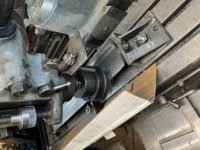Overland
Stainless
- Joined
- Nov 19, 2017
- Location
- Greenville, SC
Just finished conversion of a Seiki BP clone by adding new Baldor 3 hp Vector duty motor, new Woods single A belt taper lock pulleys, new belt.
The machine ran fine with the old Reeves pulley system, until the belt crapped out, so I took the opportunity to rebuild the drive system
I have a fairly strong vibration 60 to 65 motor Hz, about 1700 to 1800 motor rpm.
I have the spindle speed at 45% of motor speed, with the pulleys I'm using. (3.8" motor, 8.2" spindle).
No vibration from 0 motor rpm, until I turn it up to about 60 Hz, then stops at 65 Hz and is fine all the way up to 150 Hz (4,400 motor rpm, about 2,000 spindle rpm).
The pulleys and belt look like they're running true.
I believe the cast iron pulleys are balanced from the factory.
The taper lock bushings aren't perfect due to the saw cut, but small dia, so maybe not much effect.
My thoughts are to remove the larger pulley (8" dia cast iron single groove pulley) and index it on the taper lock bushing to find a "sweet spot". Could be a tedious process.
I doubt the motor is the issue, as it's a brand new Baldor, rated up to 6,000 rpm.
I guess I could try it in back gear, to possibly eliminate the spindle.
Any other suggestions or experience to share please, please ?
Bob
The machine ran fine with the old Reeves pulley system, until the belt crapped out, so I took the opportunity to rebuild the drive system
I have a fairly strong vibration 60 to 65 motor Hz, about 1700 to 1800 motor rpm.
I have the spindle speed at 45% of motor speed, with the pulleys I'm using. (3.8" motor, 8.2" spindle).
No vibration from 0 motor rpm, until I turn it up to about 60 Hz, then stops at 65 Hz and is fine all the way up to 150 Hz (4,400 motor rpm, about 2,000 spindle rpm).
The pulleys and belt look like they're running true.
I believe the cast iron pulleys are balanced from the factory.
The taper lock bushings aren't perfect due to the saw cut, but small dia, so maybe not much effect.
My thoughts are to remove the larger pulley (8" dia cast iron single groove pulley) and index it on the taper lock bushing to find a "sweet spot". Could be a tedious process.
I doubt the motor is the issue, as it's a brand new Baldor, rated up to 6,000 rpm.
I guess I could try it in back gear, to possibly eliminate the spindle.
Any other suggestions or experience to share please, please ?
Bob





